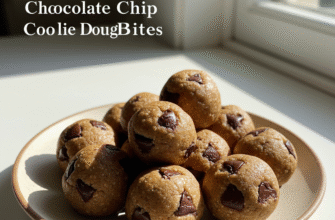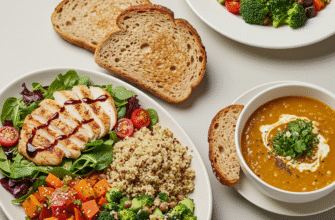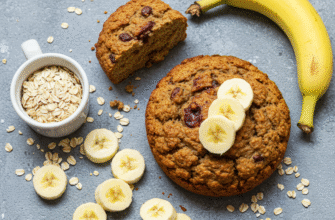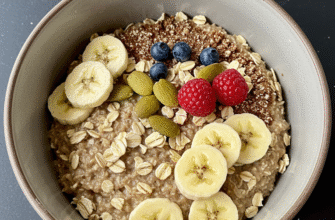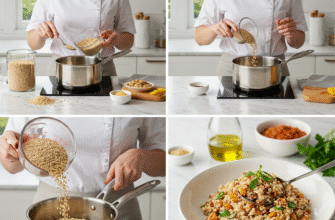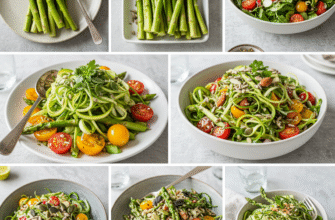Chicken salad often conjures images of creamy, comforting goodness, perfect for sandwiches, wraps, or scooped onto crackers. But let’s be honest, traditional recipes can sometimes feel like a mayonnaise delivery system, hiding the fresh flavors of the chicken and mix-ins under a heavy blanket. If you’re looking for ways to enjoy this classic dish with a lighter touch, you’ve come to the right place. We’re diving into the world of healthy chicken salad recipes that dial back the mayo without sacrificing flavor or satisfaction.
Moving away from a mayo-heavy base opens up a world of exciting taste and texture possibilities. It’s not just about cutting calories or fat; it’s about letting the other ingredients shine. Think vibrant herbs, crisp vegetables, tangy dressings, and perfectly cooked chicken taking center stage. You might be surprised how much more dynamic and refreshing chicken salad can be when mayo plays a supporting role rather than the lead.
Rethinking the Creamy Base: Mayo Alternatives
The key to a fantastic light chicken salad is finding a binder that provides creaminess and moisture without relying solely on mayonnaise. Luckily, there are plenty of delicious and readily available options:
Greek Yogurt: This is probably the most popular swap. Plain Greek yogurt offers a similar thick, creamy texture to mayo but with a pleasant tanginess and a significant protein boost. Opt for full-fat or low-fat plain versions for the best results; non-fat can sometimes be a bit too watery or tart. It pairs beautifully with lemon juice, dill, and cucumber.
Avocado: Mashed ripe avocado creates an incredibly luscious, smooth base packed with healthy fats. It lends a subtle, slightly grassy flavor and a beautiful pale green hue to the salad. A squeeze of lime or lemon juice is essential to prevent browning and brighten the taste. This works wonderfully with southwestern or cilantro-lime flavor profiles.
Hummus: For a completely different vibe, consider using hummus as your binder. It adds creaminess along with its distinct nutty, savory flavor from chickpeas and tahini. This is particularly great for Mediterranean-inspired chicken salads, complementing ingredients like olives, feta, and sun-dried tomatoes.
Vinaigrettes: Who says chicken salad has to be creamy? A well-balanced vinaigrette – think lemon-herb, balsamic, or Dijon-based – can lightly coat the ingredients, adding moisture and zesty flavor without any heaviness. This approach results in a much brighter, more ‘salad-like’ chicken salad.
Mustard Power: Don’t underestimate the power of mustard. Dijon, whole grain, or even a spicy brown mustard can add significant flavor and some binding power, especially when combined with a little olive oil, lemon juice, or a small dollop of Greek yogurt or mayo. It cuts through richness and adds a sophisticated kick.
The Hybrid Approach: You don’t have to ditch mayo entirely! Often, the best approach is to simply reduce the amount of mayonnaise significantly and combine it with one of the alternatives above. Using half Greek yogurt and half mayonnaise, for instance, gives you some of that classic mayo flavor and richness but lightens the overall profile considerably.
Building Blocks of a Great Light Chicken Salad
Beyond the base, several components contribute to a truly memorable chicken salad.
The Star: Perfectly Cooked Chicken
The quality of your chicken is paramount. You want tender, flavorful meat. Overcooked, dry chicken will ruin even the best dressing.
- Poaching: Gently simmering boneless, skinless chicken breasts or thighs in lightly salted water or broth until just cooked through yields incredibly moist results. Adding aromatics like onion, celery, bay leaf, or peppercorns to the poaching liquid infuses extra flavor.
- Baking or Roasting: Season chicken breasts or thighs and bake until cooked through. This method develops a slightly deeper flavor compared to poaching.
- Grilling: Grilled chicken adds a wonderful smoky dimension that complements many lighter dressings, especially vinaigrettes or avocado-based salads.
- Rotisserie Chicken: For convenience, a store-bought rotisserie chicken is a fantastic shortcut. Just be mindful of the sodium content and remove the skin.
Once cooked and cooled slightly, you can either dice the chicken into uniform cubes or shred it using two forks or even a stand mixer fitted with the paddle attachment (a great trick for large batches!). Shredded chicken tends to incorporate better with creamier bases, while diced chicken offers distinct bites.
Essential Crunch and Texture
Texture is crucial in preventing a monotonous mouthful. Crisp elements provide contrast and freshness.
- Celery: The classic choice for a reason. It offers a mild flavor and unparalleled watery crunch. Dice it finely.
- Onion: Red onion provides a sharp bite and color, while green onions (scallions) offer a milder flavor. Shallots are a more delicate option. Finely mince them.
- Bell Peppers: Red, yellow, or orange bell peppers add sweetness, color, and a satisfying crunch.
- Apples: Varieties like Fuji, Gala, or Honeycrisp add sweetness, tartness, and a firm crunch. Dice them relatively small.
- Grapes: Halved or quartered seedless grapes (red or green) provide bursts of juicy sweetness.
- Nuts and Seeds: Toasted pecans, walnuts, almonds (slivered or sliced), sunflower seeds, or pepitas contribute nutty depth and fantastic texture. Toasting enhances their flavor.
- Water Chestnuts: Canned water chestnuts, drained and chopped, retain their unique crispness even when mixed into the salad.
Flavor Boosters: Herbs, Spices, and More
This is where you can really customize your salad and make it sing, especially when reducing the dominant flavor of mayo.
- Fresh Herbs: Absolutely essential! Dill, parsley, chives, tarragon, cilantro, and basil add brightness and complexity. Use them generously.
- Acidity: Lemon juice or zest, lime juice, or various vinegars (apple cider, white wine, red wine) cut through richness and brighten flavors.
- Spices: Salt and freshly ground black pepper are non-negotiable. Beyond that, consider paprika (sweet or smoked), curry powder, garlic powder, onion powder, celery salt, or cayenne pepper for heat.
- Pickled Elements: Finely chopped pickles, relish (dill or sweet), or capers add tangy, briny notes that complement the chicken beautifully.
- Dried Fruit: Dried cranberries, cherries, raisins, or chopped apricots can add chewy texture and concentrated sweetness, balancing savory elements.
Light & Flavorful Chicken Salad Ideas
H3: Classic Refresh: Greek Yogurt & Dill Chicken Salad
This version leans heavily on plain Greek yogurt for its creamy base, making it tangy and protein-rich. Combine shredded or diced cooked chicken with Greek yogurt, a generous amount of chopped fresh dill, finely diced celery, and a squeeze of fresh lemon juice. Season well with salt and pepper. A little Dijon mustard or some finely minced red onion can be added for extra zip. It’s clean, refreshing, and feels instantly lighter than its mayo-based cousin.
H3: Creamy Green Dream: Avocado & Cilantro Lime Chicken Salad
Mash a ripe avocado with lime juice until mostly smooth (a few small lumps are fine). Gently fold in diced cooked chicken, finely chopped red onion, chopped fresh cilantro, and perhaps some diced jalapeño for a touch of heat. Season with salt, pepper, and maybe a pinch of cumin. The avocado provides healthy fats and a luxurious texture, while the lime and cilantro keep it bright and zesty. This is fantastic in lettuce wraps or served with tortilla chips.
H3: Mediterranean Delight Chicken Salad
Skip the creamy base altogether or use a touch of hummus. Toss diced cooked chicken with chopped cucumber, halved cherry tomatoes, sliced Kalamata olives, crumbled feta cheese, and chopped fresh parsley or oregano. Dress it lightly with a simple lemon-olive oil vinaigrette (lemon juice, olive oil, salt, pepper, maybe a pinch of dried oregano). Sun-dried tomatoes packed in oil (drained and chopped) or chopped roasted red peppers are also excellent additions for a taste of the Mediterranean.
Flavor Synergy: Don’t be afraid to mix and match binders and flavor profiles. A touch of Greek yogurt can soften the intensity of an avocado base. A spoonful of mayonnaise might round out the tang of a primarily yogurt-based salad. The key is finding balance and letting the fresh ingredients complement each other.
H3: Light Curry Chicken Salad with Apples & Raisins
Create a lighter curry dressing by mixing Greek yogurt (or a blend of yogurt and light mayo) with curry powder, a pinch of turmeric (for color), salt, and pepper. You might add a tiny bit of mango chutney or honey for sweetness. Fold in diced cooked chicken, finely chopped celery, diced apple (like Gala or Fuji), and a handful of raisins or chopped toasted almonds. The combination of warm spice, sweet fruit, and crunchy elements is always a winner.
Tips for Lighter Chicken Salad Success
Taste and Adjust: Since you’re using less mayo, seasoning becomes even more critical. Taste your salad frequently as you build it, adjusting salt, pepper, acidity (lemon/vinegar), and herbs until the flavors pop. Remember that flavors will meld and intensify slightly as the salad chills.
Chill Out: Letting your chicken salad rest in the refrigerator for at least 30 minutes before serving allows the ingredients to get acquainted and the flavors to deepen. This is especially important for salads using yogurt or vinaigrettes.
Consistency Control: If your salad seems too thick (especially with yogurt or avocado), you can thin it slightly with a splash of lemon juice, a touch of olive oil, or even a little water or chicken broth. If it’s too thin, adding more chicken or crunchy vegetables can help.
Smart Serving: Serve your healthy chicken salad in Boston or romaine lettuce cups for a naturally low-carb option. Pile it onto whole-wheat crackers, tuck it into whole-grain pita bread, serve it atop mixed greens, or simply enjoy it on its own. It’s incredibly versatile.
Storage Smarts: Store leftover chicken salad in an airtight container in the refrigerator. Generally, it’s best consumed within 3 days. Salads made with avocado may brown slightly, though the citrus juice helps mitigate this; they are often best eaten within a day or two.
Food Safety First: Always ensure your chicken is cooked to a safe internal temperature (165°F or 74°C). Cool the chicken promptly before mixing the salad, and do not leave the finished chicken salad at room temperature for more than two hours (or one hour if the ambient temperature is above 90°F or 32°C).
Making delicious, satisfying chicken salad doesn’t require drowning it in mayonnaise. By exploring creative binders like Greek yogurt, avocado, or light vinaigrettes, and focusing on fresh ingredients, ample crunch, and vibrant flavor boosters, you can create endless variations that are both lighter and arguably more exciting than the traditional version. So go ahead, experiment, and rediscover your love for chicken salad – the lighter, brighter way!

